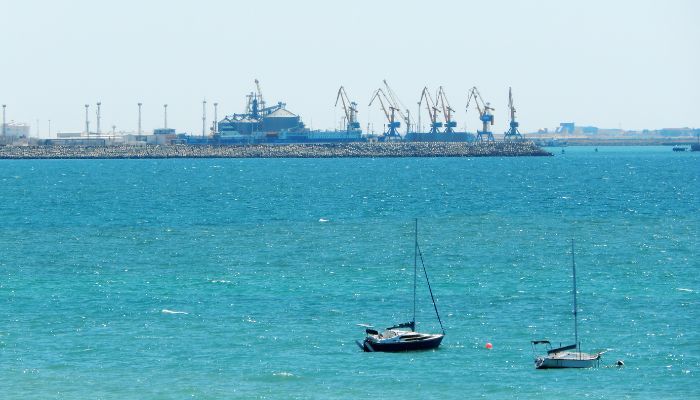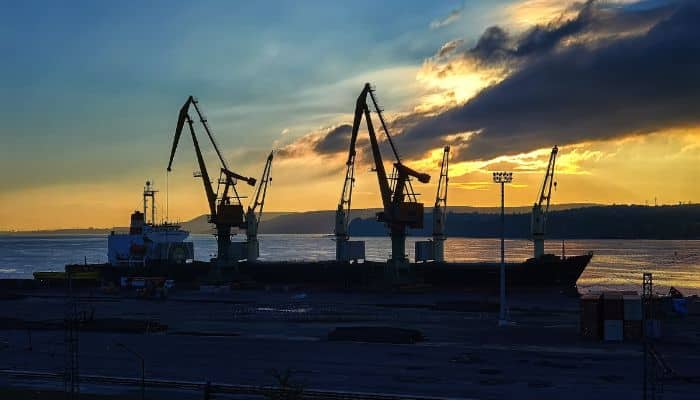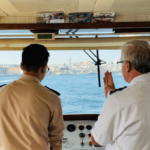10 Major Caspian Sea Ports
The Caspian Sea is a landlocked water body, often called the world’s largest lake, situated between Europe and Asia. It is surrounded by five nations; Kazakhstan, Russia, Turkmenistan, Iran and Azerbaijan.
It is quite rich in natural gas reserves and oil, found in offshore deposits and onshore fields too. Per estimates, it contains 48 billion barrels of oil and 8.7 trillion m3 of gas, much of which has not been tapped.
The Caspian Sea is vital for transporting these energy resources from landlocked nations to global markets, making it a key link in the global energy supply chain. It also supports the fishing industry, offering livelihood and food security to many living near its coast. The sea has an abundance of fish, like the sturgeon, renowned for the production of caviar.
Its coastal regions are bustling with tourists due to the presence of beautiful beaches and many fun activities like sailing, boating or fishing.
In this article, let us explore the ten major Caspian Sea Ports.
1. Baku Port, Azerbaijan
Baku is the capital and the biggest city of Azerbaijan. It is also a prominent city on the Caspian Sea and the Caucasus region. It is around 28 m or 92 ft below sea level, making it the lowest-lying capital city in the world.
It is situated on the southern banks of the Absheron Peninsula, on the Baku Bay. It serves as the cultural, scientific and industrial hub of the country and many important Azerbaijani institutions are located there.

The city has a semi-arid climate and has several mud volcanoes and salt lakes.
The city is 40 kilometres from the port, also called the Port of Baku. It has a natural harbour and functions as a transhipment point for petroleum products and oil and gas-related industries.
It also handles general cargo and timber destined for western parts of Europe. Baku Port offers passenger services to the eastern and western shores of the Caspian Sea.
The port covers 400 ha and has 13 berths. It has a total handling capacity of 15 million tonnes and can accommodate 100,000 TEUs as well. It has 56,000 m2 of open storage and 10,000 m2 of warehouse space.
2. Aktau Port, Kazakhstan
Aktau Port is situated south of the Mangyshlak Peninsula on the eastern coast of the Caspian Sea.
It is strategically located at the intersection of many international transportation corridors, which enables it to transport dry cargo, crude oil and petroleum products to and from Iran, Turkey, Russia, Turkmenistan and Azerbaijan.

It is the only ice-free port in the country and mainly deals with cargo reshipment. The main commodities handled here are sawn timber, oil products, metals, bulk products etc. The port has 11 berths, 4 of which are designated for oil products only.
It has an annual cargo handling capacity of 17.7 million tonnes. It also has a 2000 m2 warehouse area and 79,700 m2 of outdoor warehouse space.
3. Astrakhan Port, Russia
Astrakhan Port lies at the mouth of the Volga River on the Volga-Caspian Canal. It is a crucial shipping hub where the Caspian Sea and Volga waterways cross.
The port is divided into 2 cargo handling areas called the Central and the Perevalochnyiis. There is an oil terminal at IIinka, Olya port and other terminals along the river bank.

In winter, the harbours along Volga freeze; hence navigation is possible from April till November.
The port deals with different types of cargo, such as metals and metal products, fertiliser, timber, construction materials, containers, petroleum products and passengers.
More than 2,000,000 tonnes of cargo, 3,000,000 tonnes of oil shipments and 1,200,000 passengers pass through this facility every year. The port has 26 docks and a 3,604 m long waterfront area.
4. Turkmenbashi Port, Turkmenistan
The Turkmenbashi seaport is the biggest harbour and the main cargo and passenger port in Turkmenistan. Located on the eastern coast of the Caspian Sea, it has a ferry terminal connecting the cities of Baku in Azerbaijan, Aktau in Kazakhstan and Astrakhan in Russia.
It has great geopolitical importance in Eurasia as it lies on the Europe-Caucasus-Asia trade route.

The port receives ships all year round and is referred to as a ‘sea gate’ linking Central Asia and Europe by sea, roads and railways. It is also a major transit hub.
It was established in 1896, and in 1903, the Merchant Marine Port Authority was founded. It was upgraded at regular intervals, and the recent expansion project was completed in 2018, involving the construction of ferry, passenger and cargo terminals. There is a plan to build a shipyard in future.
It has a quay length of 1800 m, enabling it to handle 17 cargo and passenger ships simultaneously.
The port has 5 terminals specialising in general cargo, bulk cargo, containerised cargo and petroleum products.
5. Bandar Anzali Port, Iran
Bandar Anzali Port lies on the northern coast of Iran on the Caspian Sea. The port is close to the city of Anzali, 380 km northwest of Tehran and 40 km from Rasht, the capital of Gilan.
The port covers 68.2 acres and has 10 jetties, each with 5000 tonnes capacity. Anzali port is northern Iran’s main port facility and also a seaside resort in the Caspian Sea.

It has facilities for dealing with breakbulk, dry bulk, liquid bulk, RORO and container cargo. The shipments leaving from Azerbaijan, Turkmenistan and Russia are discharged at this port.
Around 4,000,000 tonnes of cargo and 1,274 vessels are handled annually at Bandar Anzali Port.
6. Port of Amirabad, Iran
Amirabad Port is located on the Caspian Sea coast, around 34 km northeast of Sari in Iran. The Amirabad Port Special Economic Zone of Beshahr is crucial for the local and national economy as it offers a competitive advantage.
It is a multipurpose facility dealing with containers, RORO, dry bulk and oil. Approximately 5 million tonnes of cargo is handled annually here.

It was to be designed in three phases, and till 2023, only the first phase has been completed. Per data, it is the 4th biggest port in Iran and one of the biggest Iranian ports on the Caspian Sea.
It is well connected with the Iranian Railway network and the North-South International Transit Corridor.
It covers 1060 hectares, with a cargo warehouse covering 6.5 hectares and another storage area spanning 200 hectares. Its annual cargo handling capacity is 7.5 million tonnes. The port has 15 berths spanning 2600 m with a draft of 6 m.
7. Makhachkala Port, Russia
Makhachkala is the socio-economic, educational and scientific centre of the North Caucasus. It has a principal seaport on the southwestern coast of the Caspian Sea in the Dagestan Republic.
It is a transportation hub and one of the fastest-growing places in Russia, experiencing a construction boom.

Makhachkala port has 2 harbours, of which one handles dry cargo and has a fishing port, while the other functions as an oil port. Both are protected by breakwaters. It is also the only ice-free Russian facility on the Caspian Sea.
It also handles transit cargo from Western Europe, Central Asia, India and Gulf regions, with facilities for oil tankers weighing 10,000 tonnes and cargo ships to 5000 tonnes.
Around 7,000,000 tonnes of oil products, 1,500,000 tonnes of mineral construction cargo, 400,000 tonnes of general and timber, as well as up to 50,000 tonnes of ore concentrate pass through this port annually.
The fishing port handles over 80,000 tonnes of fish products, including fish meal.
8. Noshahr/ Nowshahr Port, Iran
Nowshahr, also called Bandar-e Noshahr and earlier known as Dehno, is a beautiful city in the Central District of Nowshahr County in Iran’s Mazandaran province. It serves as the capital of the county and also of the district.
It has a subtropical climate accompanied by warm and humid summers and cool and damp winters.

Bandar Noshahr is located on the southern coast of the Caspian Sea, 194 km north of Tehran and 200 km from Sari, the capital of Mazandaran.
It is a multipurpose facility and also consists of the Khazar Special Economic Zone.
Noshahr Port imports chemicals, metals, spare parts, steel, oil, construction material and timber. It exports fruits and vegetables, dairy, nuts and minerals.
The port deals with approximately 1,500,000 tonnes of cargo every year. It can accommodate vessels with a maximum LOA of 150 m, a 5 m draught and weighing around 5000 DWT.
9. Port of Kuryk, Kazakhstan
Kuryk Port is located on the coast of the Caspian Sea in Kazakhstan’s Mangistau region.
It was established as a point for exporting crude oil from the Kashagan oil fields to Baku in Azerbaijan, from where it would be transferred to Turkey through the oil pipeline.

Kuryk lies at the intersection of important maritime gateways and is one of the quickest multimodal routes for shipping cargo.
It has improved trade contacts between Kazakhstan and nations bordering the Caspian Sea. It also ships diesel, mineral fertilisers and Barite from the central Kazakh region of Karagandy.
Kuryk comprises a finger pier with 3 berths and a wharf for handling RORO ferries. It also has a general cargo terminal.
Its ferry terminal became operational in 2016, and the port transshipped 1.5 million tonnes of grain, petroleum products, fertiliser and chemicals in 2017.
10. Neka Port, Iran
Neka lies in Iran and handles mainly oil. The Neka Oil Terminal is situated in Mazandaran Province, on the southern rim of the Caspian Sea. The terminal consists of 5 jetties.
Given the strategic position of Iran, it plays a crucial role in the transportation and transit of crude oil from Central Asian Nations to other countries. Hence, infrastructural upgrades have been carried out at the Neka port so it can carry on this task.

The main reason behind the development of the Behshahr Operational Zone or Neka is to receive, store, process and transport crude oils from the Caspian Sea marginal states under the SWAP plan.
The port also receives general cargo vessels with a maximum LOA being 180 m. The port’s North Oil Terminal currently receives oil products from neighbouring countries.
You might also like to read-
- 10 Major Ports On The Great Lakes
- 10 Biggest River Ports In The World
- What Ships Sailed With The Mayflower?
- 10 Largest Natural Ports
- 10 Major Ports In Canada
Disclaimer :
The information contained in this website is for general information purposes only. While we endeavour to keep the information up to date and correct, we make no representations or warranties of any kind, express or implied, about the completeness, accuracy, reliability, suitability or availability with respect to the website or the information, products, services, or related graphics contained on the website for any purpose. Any reliance you place on such information is therefore strictly at your own risk.
In no event will we be liable for any loss or damage including without limitation, indirect or consequential loss or damage, or any loss or damage whatsoever arising from loss of data or profits arising out of, or in connection with, the use of this website.
Do you have info to share with us ? Suggest a correction
Disclaimer :
The information contained in this website is for general information purposes only. While we endeavour to keep the information up to date and correct, we make no representations or warranties of any kind, express or implied, about the completeness, accuracy, reliability, suitability or availability with respect to the website or the information, products, services, or related graphics contained on the website for any purpose. Any reliance you place on such information is therefore strictly at your own risk.
In no event will we be liable for any loss or damage including without limitation, indirect or consequential loss or damage, or any loss or damage whatsoever arising from loss of data or profits arising out of, or in connection with, the use of this website.

About Author
Zahra is an alumna of Miranda House, University of Delhi. She is an avid writer, possessing immaculate research and editing skills. Author of several academic papers, she has also worked as a freelance writer, producing many technical, creative and marketing pieces. A true aesthete at heart, she loves books a little more than anything else.
Latest Maritime Knowledge Articles You Would Like:
Daily Maritime News, Straight To Your Inbox
Sign Up To Get Daily Newsletters
Join over 60k+ people who read our daily newsletters
By subscribing, you agree to our Privacy Policy and may receive occasional deal communications; you can unsubscribe anytime.















